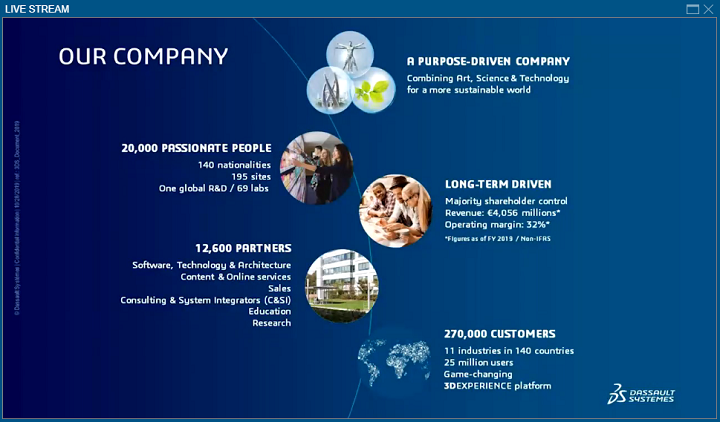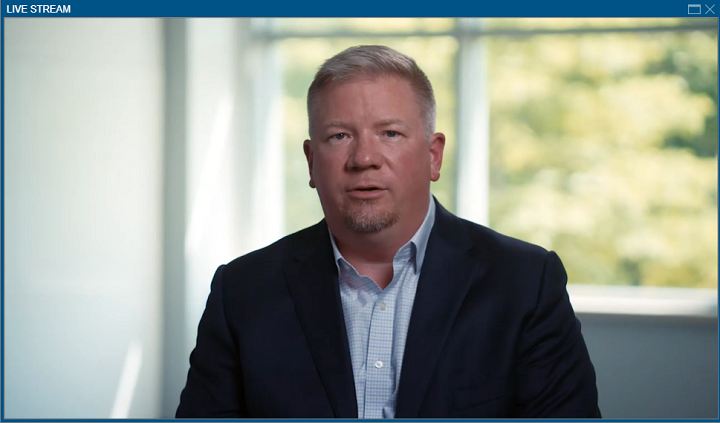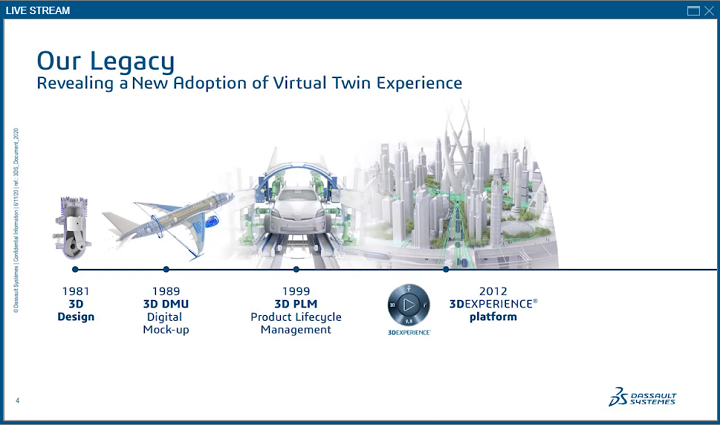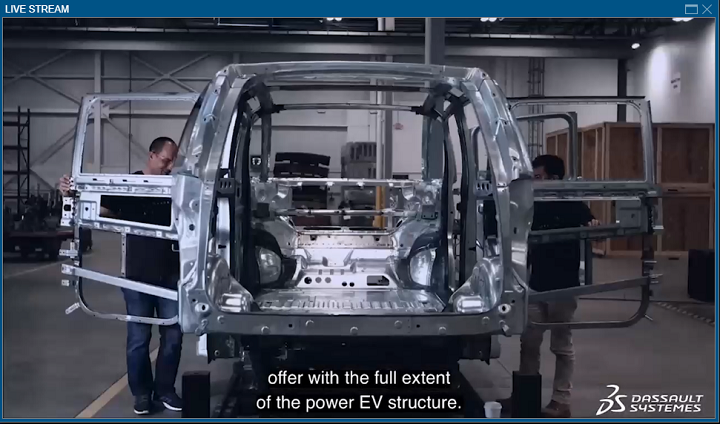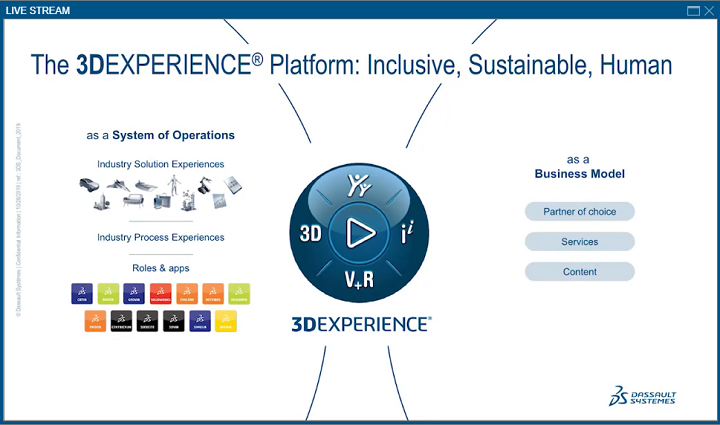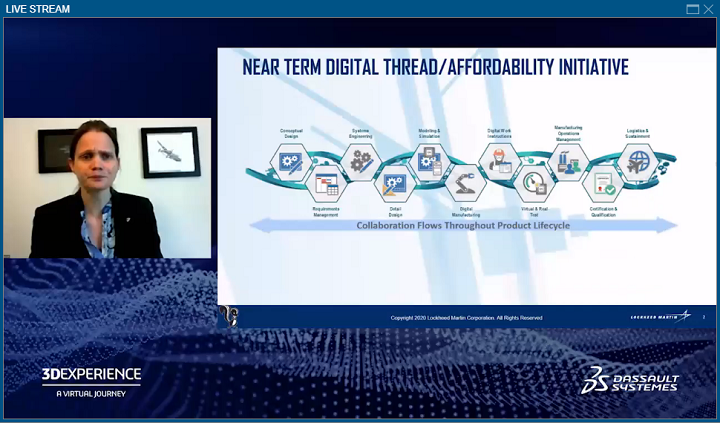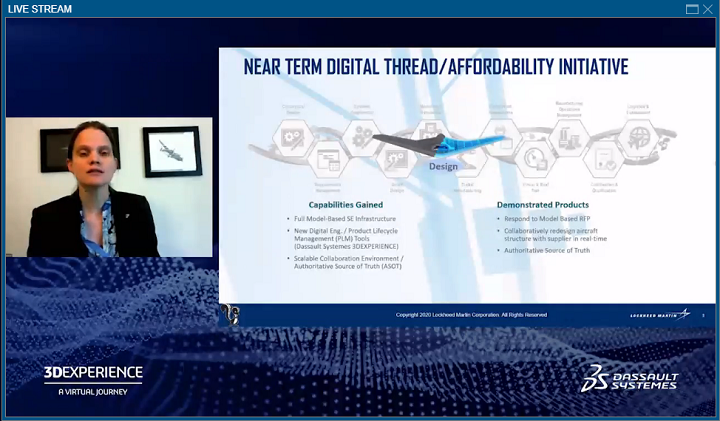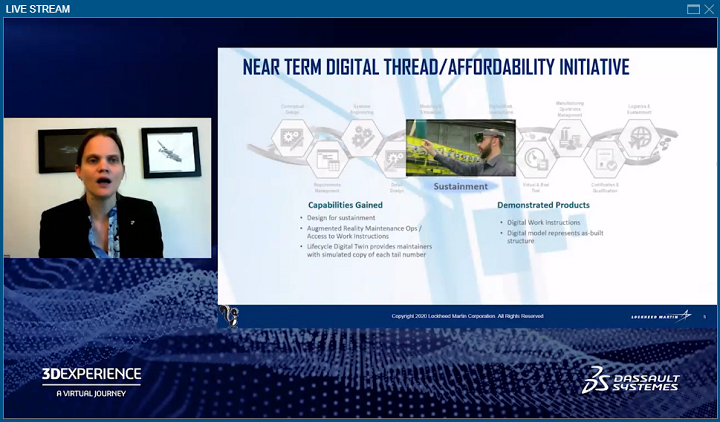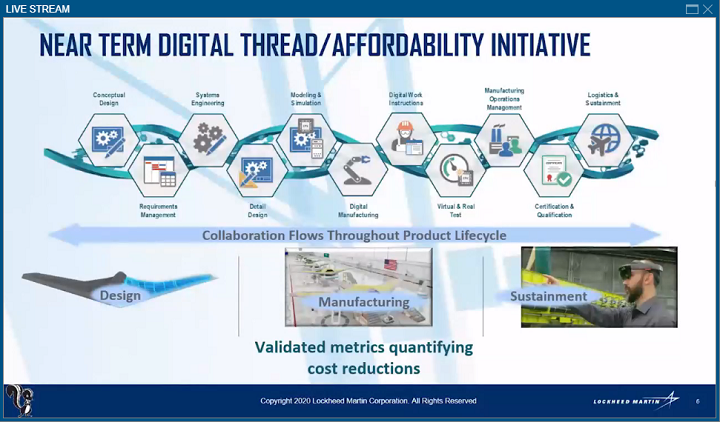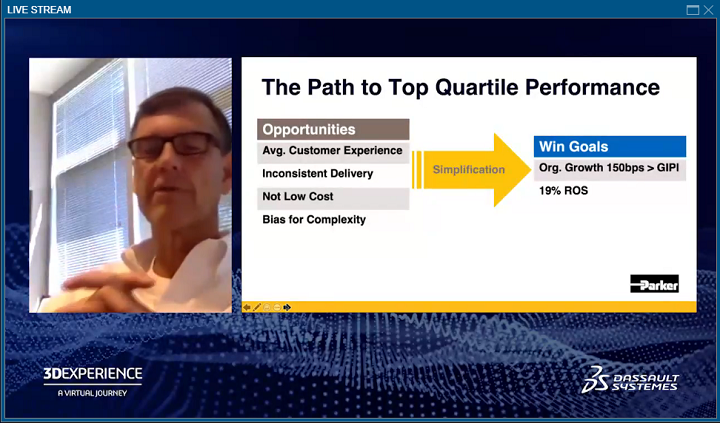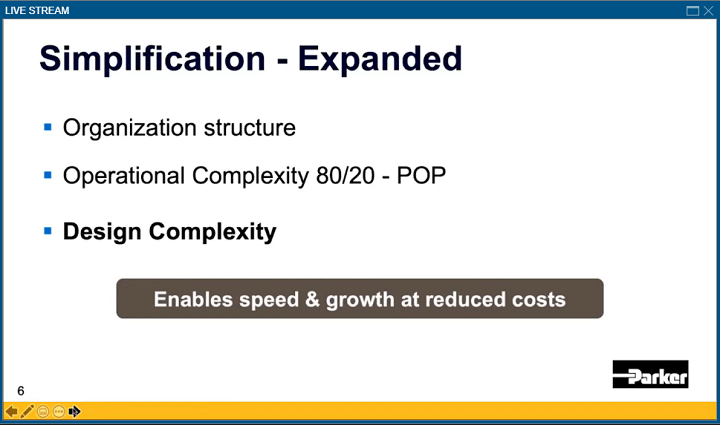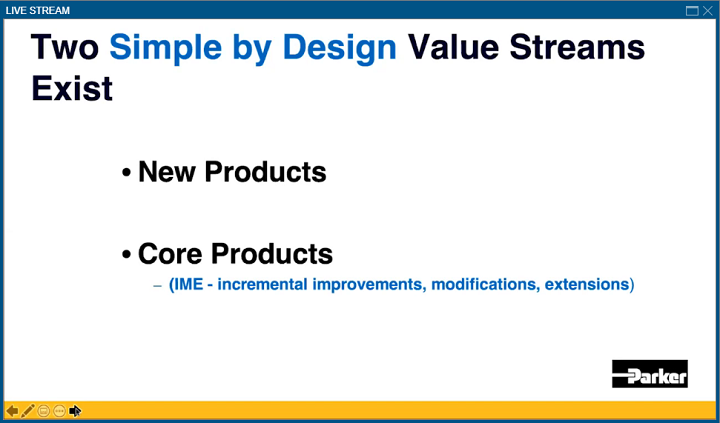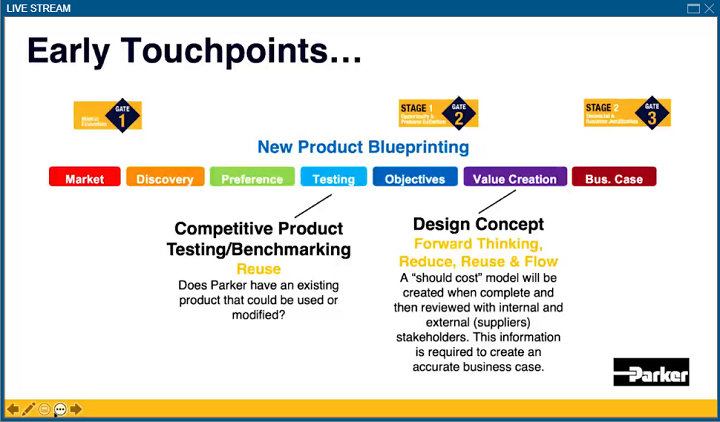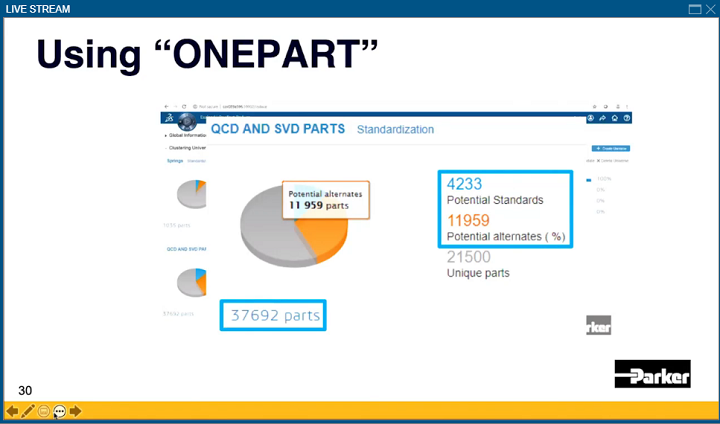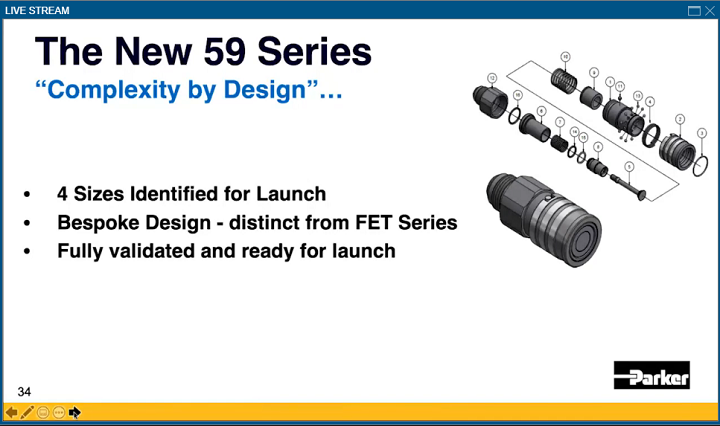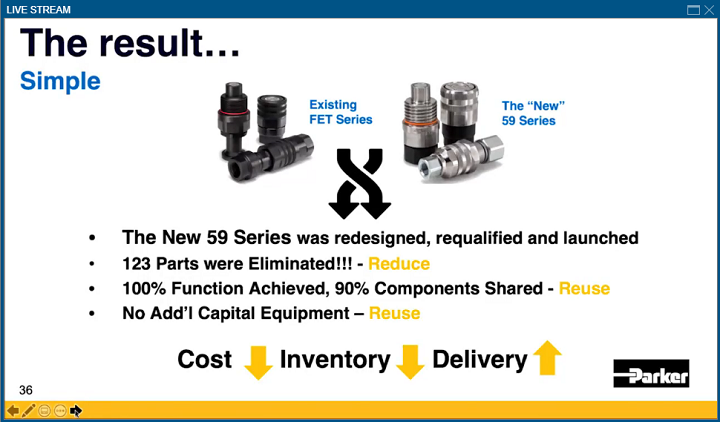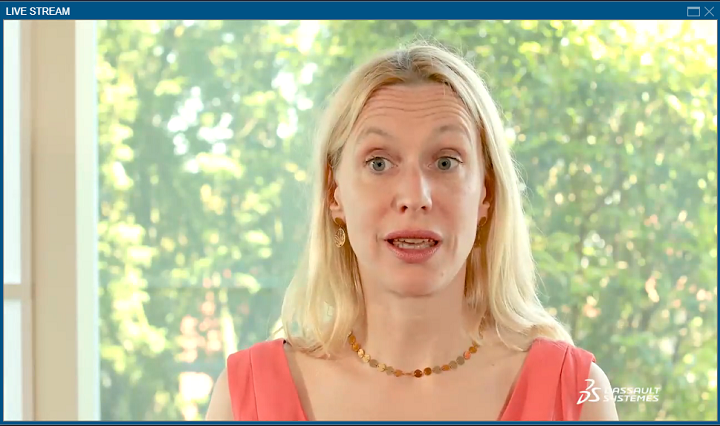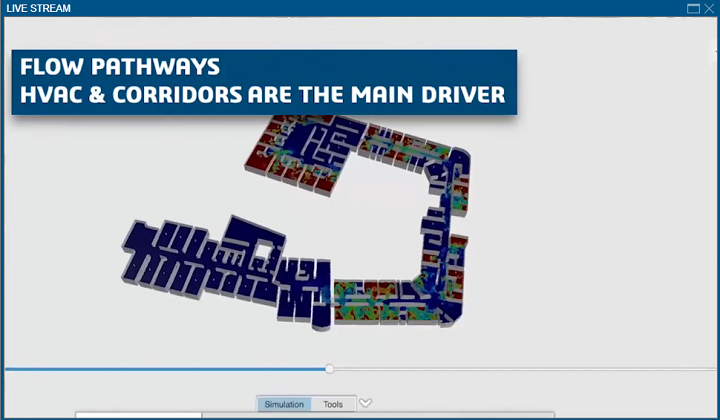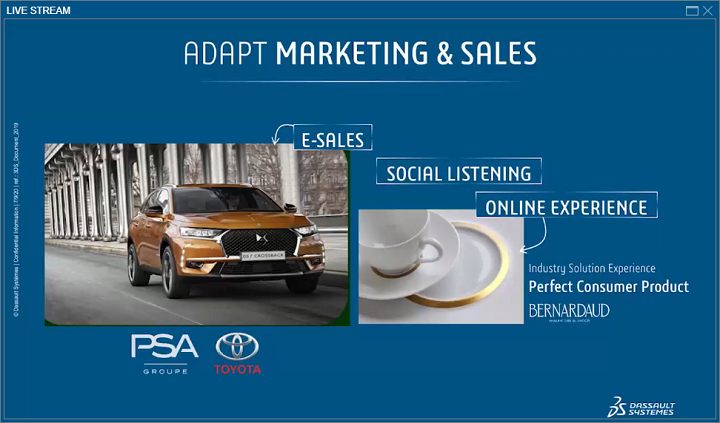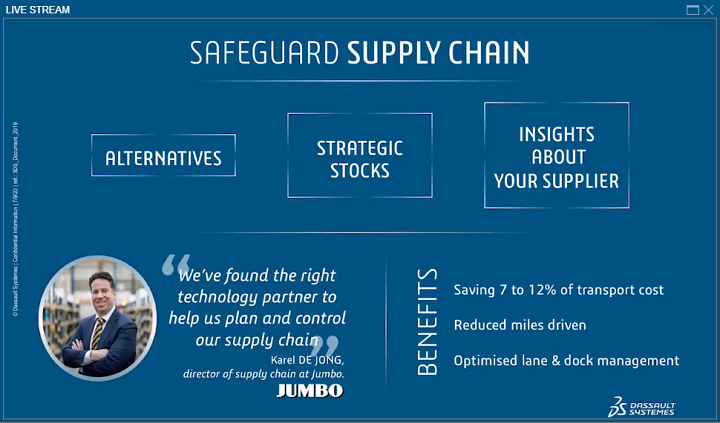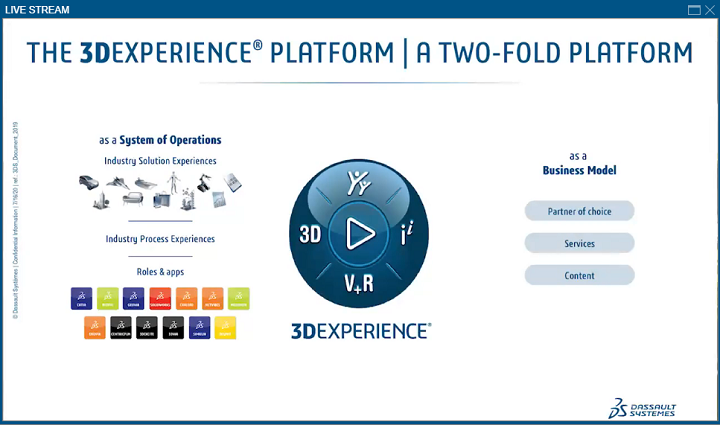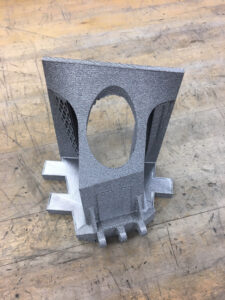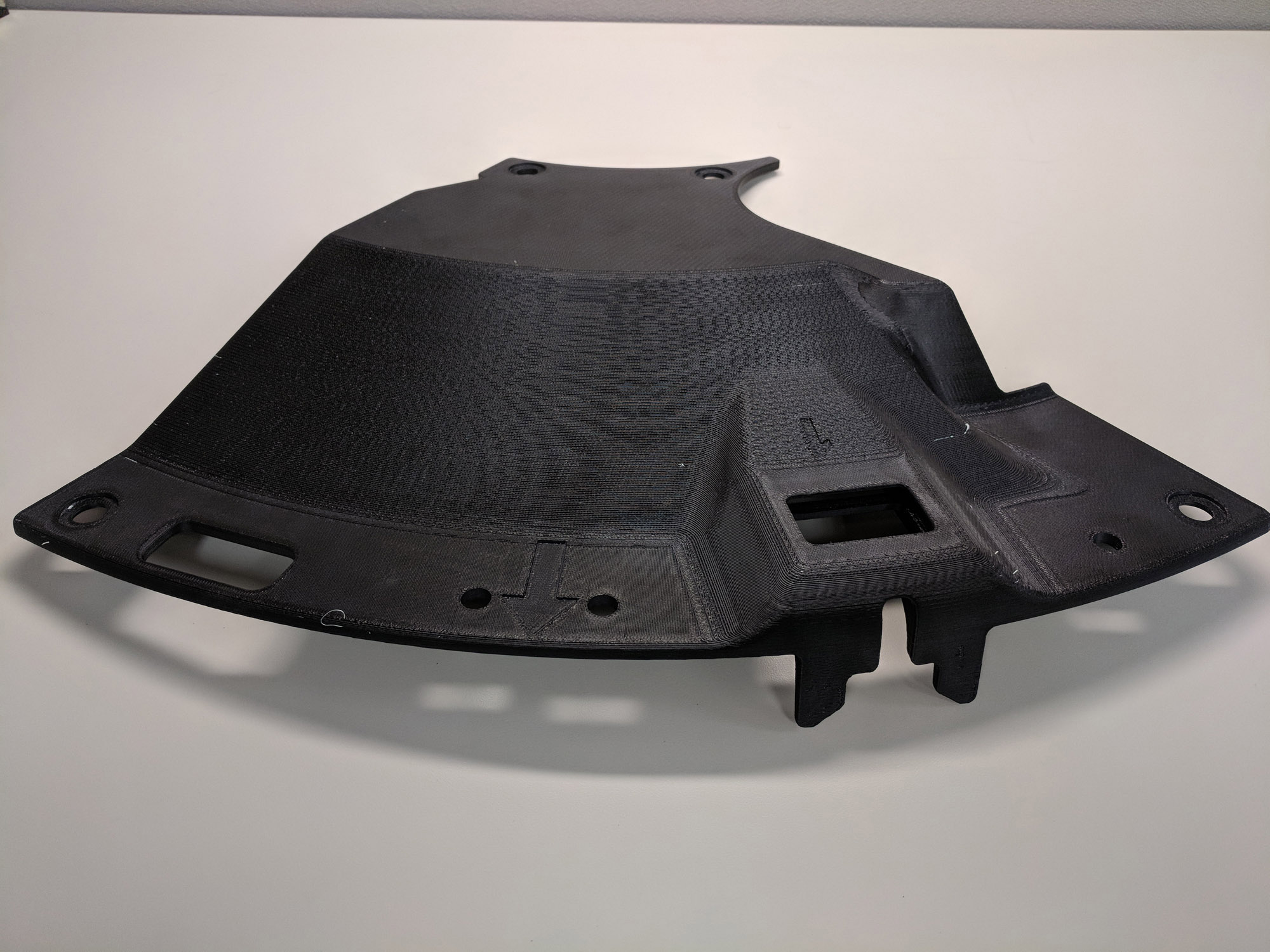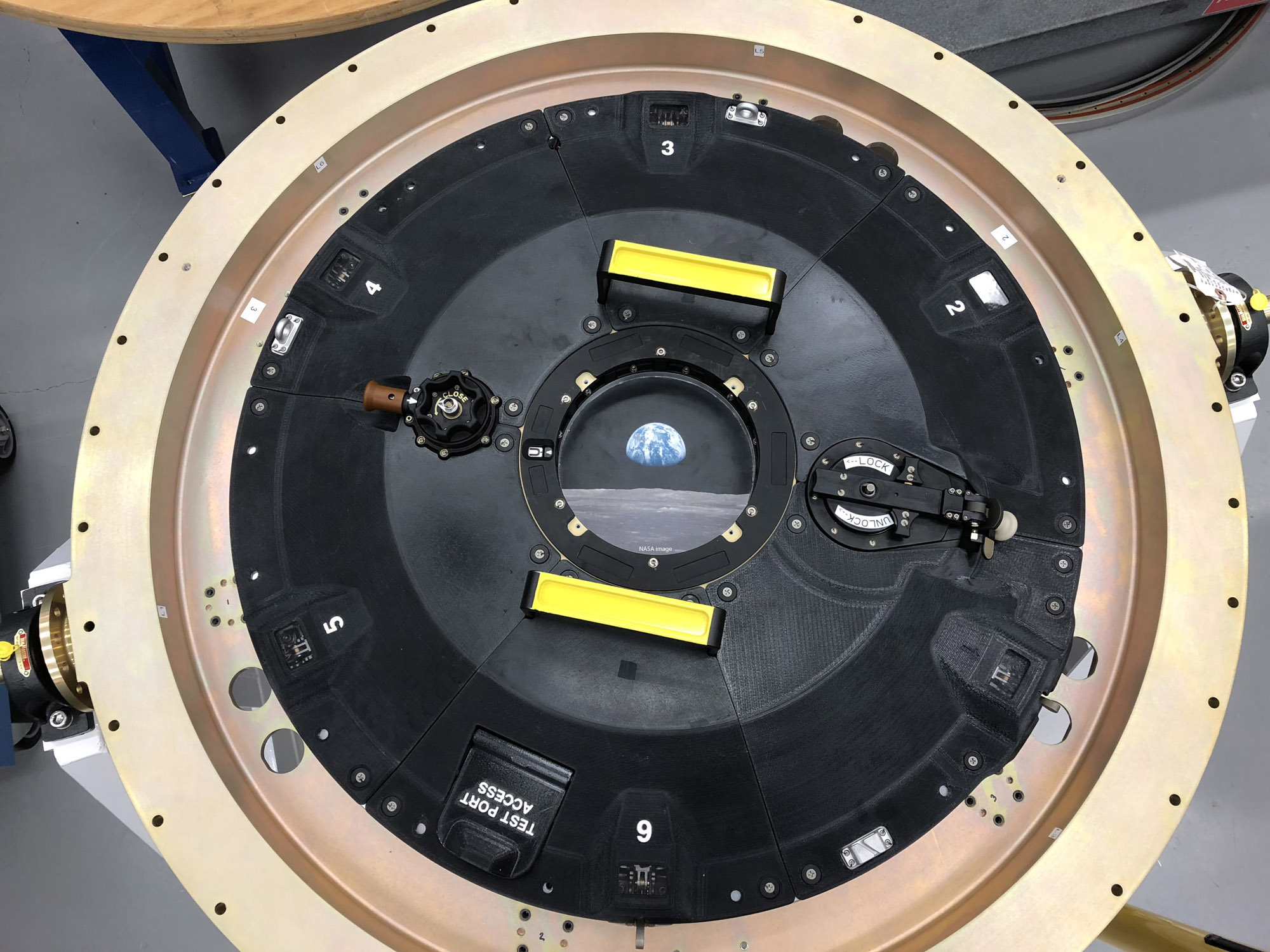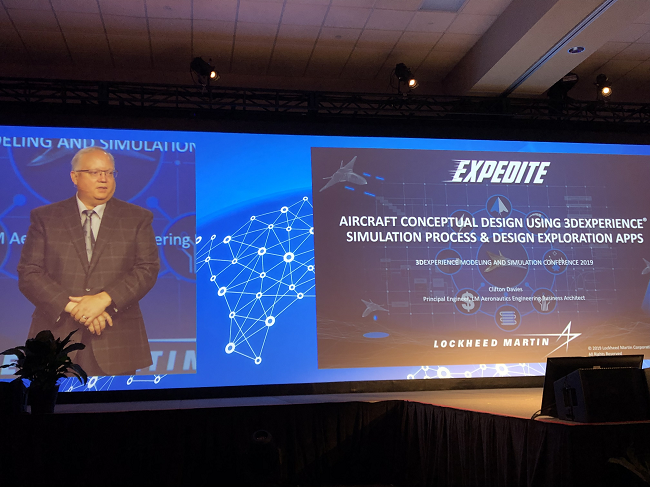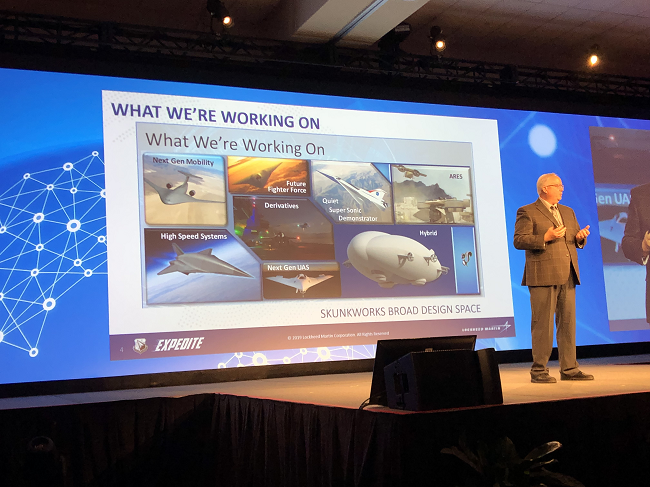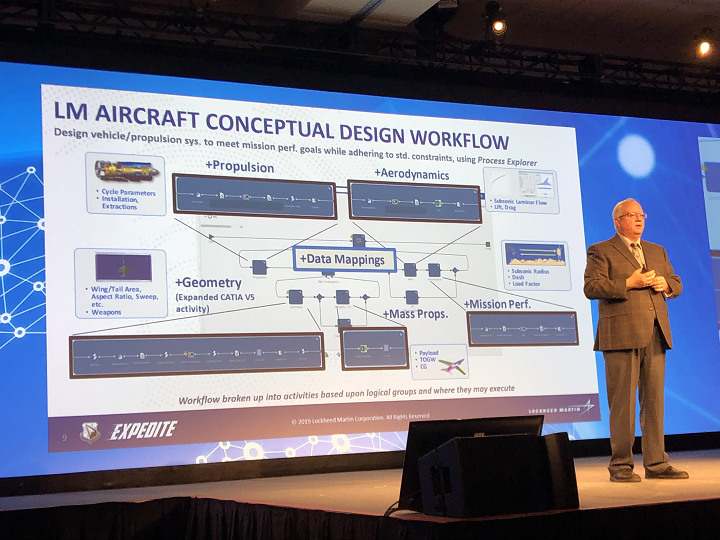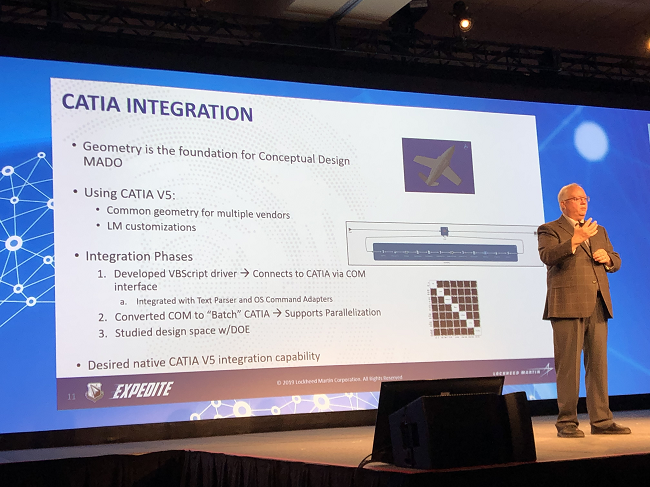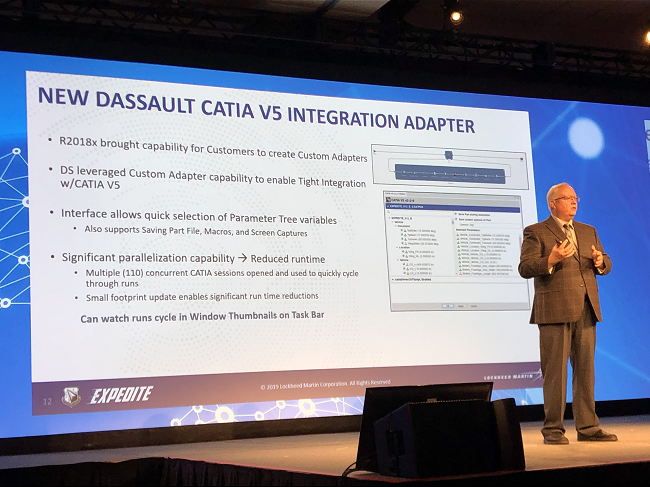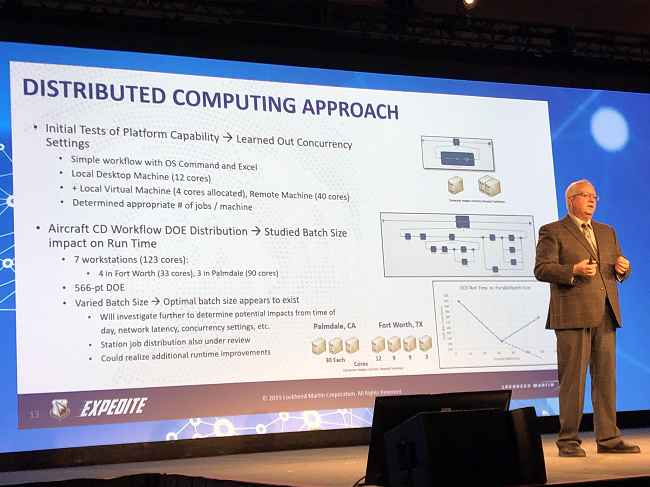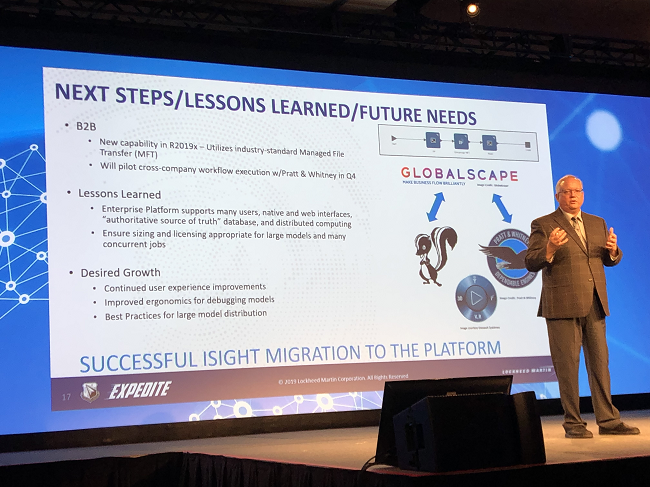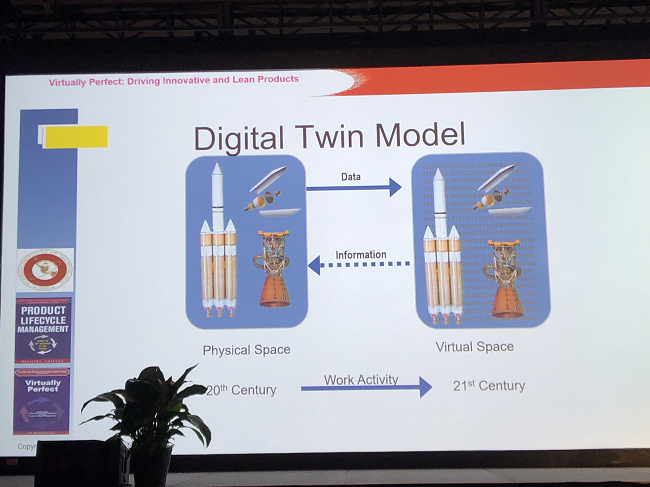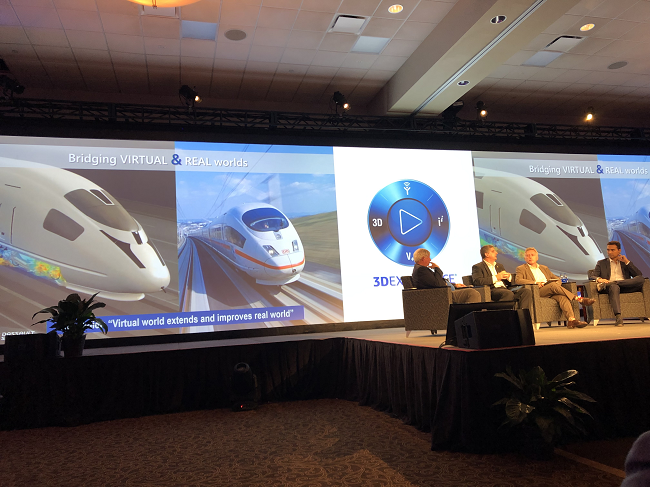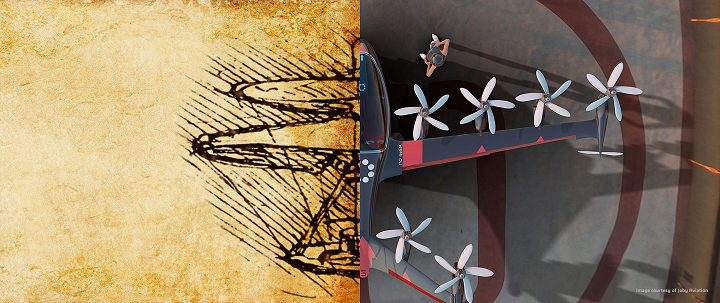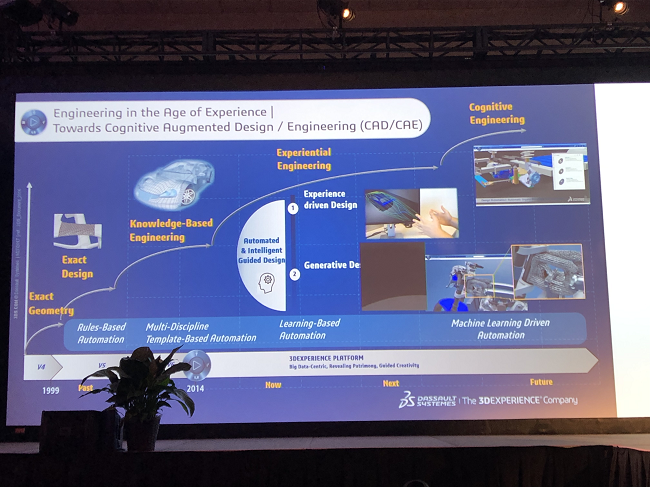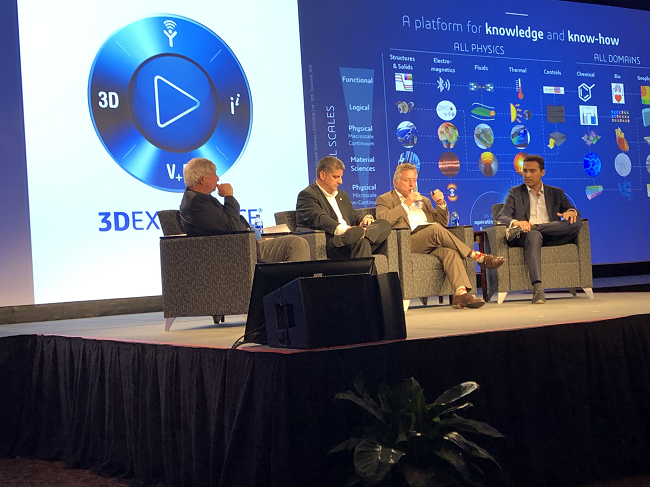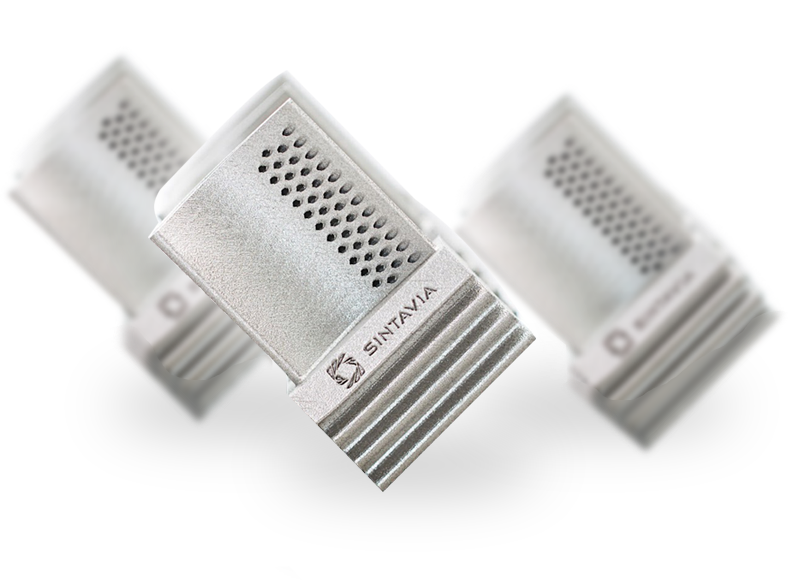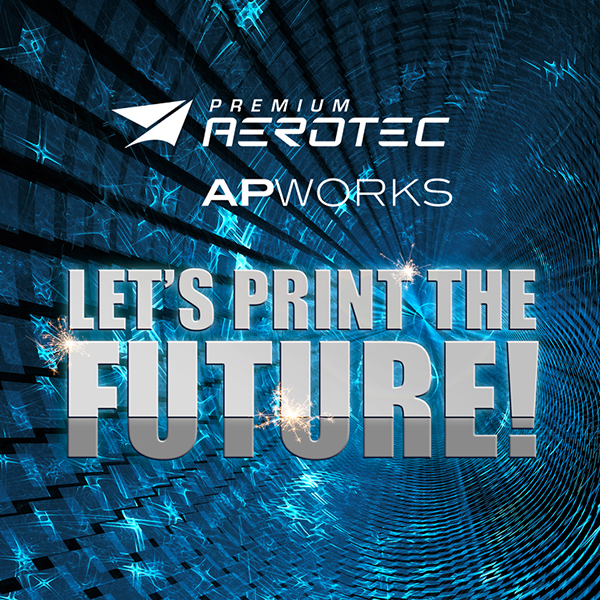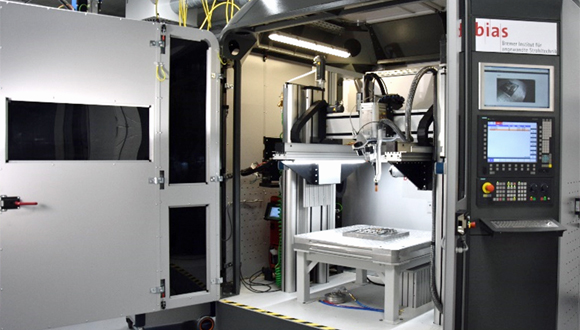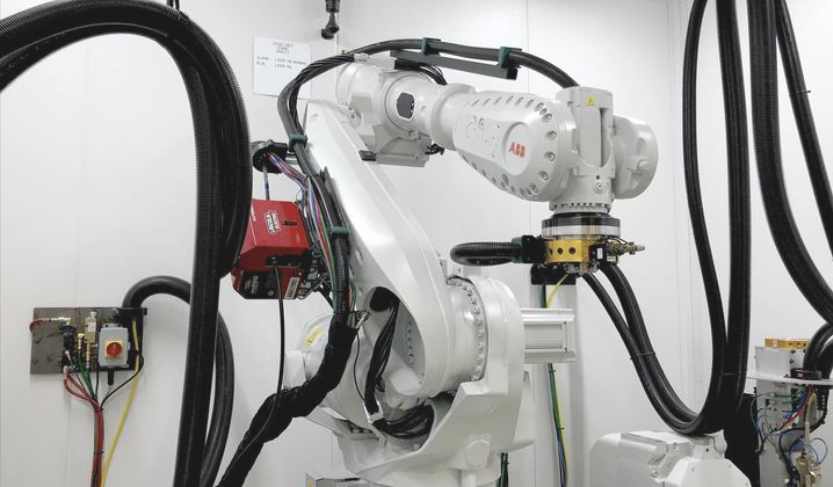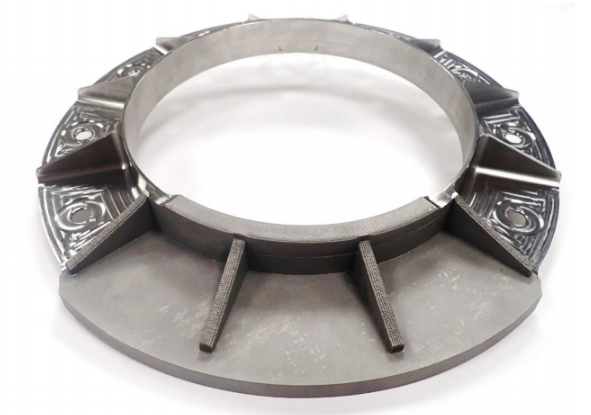3DEXPERIENCE: A Virtual Journey, Part 1
Due to the ongoing COVID-19 crisis, this year’s 3DEXPERIENCE Forum by Dassault Systèmes had to be re-imagined as a virtual event, just like so many other conferences. At 1 pm EDT on July 29th, nearly two months after the in-person event was meant to have taken place in Florida, the company began the live stream of the Plenary Session for “3DEXPERIENCE: A Virtual Journey,” a series of digital programming that replaced the annual North America customer event.
Unfortunately, the webinar seemed to be having issues, which continued on and off over the next two hours of the live stream, so I missed pieces here and there. Technical difficulties happen all the time at live events, too, so the only real difference here was that I couldn’t raise my hand and say, “I’m sorry, the audio and picture cut out, could you repeat that please?” Luckily, Dassault had the webinar up to view on-demand the very next day, so I was able to go back and check out the parts that I had missed.
Erik Swedberg, Managing Director, North America, Dassault Systèmes, got things started with his segment on “Business in the Age of Experience: Challenges and Opportunities for North America,” which focused on manufacturing and supply chains, and why companies looking to transform, some sooner than they’d hoped due to the pandemic, should “invent the industry of tomorrow,” rather than trying to digitize the past or the present.
“Yesterday, businesses focused on automation of the manufacturing system; this is Industry 4.0. Today, many industrials are digitizing the enterprise system. It’s not enough. You need to create experiences. Tomorrow, the game changers will be those with the best developed knowledge and know-how assets. Why? Simple. Because the Industry Renaissance is about new categories of new industrials creating new categories of solutions for new categories of consumers,” Swedberg said.
He mentioned Tesla and Amazon, companies in Silicon Valley working to create autonomous vehicles, and fab labs creating and printing smart, connected objects.
“The 3DEXPERIENCE platform is a platform for knowledge and know-how—a game changer, collaborative environment that empowers businesses and people to innovate in an entirely new way,” he continued. “Digital experience platforms for industry, urban development, and healthcare will become the infrastructure for the 21st century.”
Swedberg explained how 3DEXPERIENCE can allow any business to become social, by connecting employee innovation into the system where the company’s products are designed. This was a common theme today, which you’ll be able to see later.
He also explained that, with Dassault’s 13 brand applications—such as SIMULIA, CATIA, and SOLIDWORKS—the company can serve a wide variety of industries, helping its customers on their journey to invent tomorrow’s industry.
“In summation, we are in the experience economy, the Industry Renaissance is here, and world events are accelerating the need for digital transformation. As the world changes, we will partner with you for success,” Swedberg concluded. “We have the people and the insights to help you on your journey.”
Dassault’s Vice Chairman & CEO Bernard Charlès was up next, speaking about “From Things to Life.” He first said that he hoped no one on the live stream, or their loved ones and colleagues, had been impacted by the COVID-19 crisis.
“We’ve gone through a tough time, all of us. And we are with you, and we are learning a lot also from the crisis,” Charlès said.
Even though I’ve worked from home for nearly four years now, other aspects of my life have been turned upside down in the last few months, and I felt a kind of solidarity whenever the session’s speakers brought up how all of our lives, and our industry, have changed. Charlès also congratulated everyone signed into the live stream on working together, and continuing to innovate, during the pandemic; the continuing health crisis was another theme that threaded throughout the plenary session.
He said that the 3DEXPERIENCE platform is about inclusiveness, “because it means ideas and people connecting.” He shared some of the work that 3DEXPERIENCE users had accomplished during the recent and varied quarantines, such as creating respirators, improving logistics, and working to make the quality of airflow in hospitals better. He said that all of these projects were done on the 3DEXPERIENCE cloud.
“So many of you accelerated the cloud implementation, to be able to work from anywhere, especially from home, during confinement time.”
He mentioned that we are moving from a product economy to an experience economy, and that, in the long run, companies will continue to produce, and maintain ownership of, products and services throughout the life cycle, while their customers will get to enjoy the experience.
“That will accelerate innovation for a sustainable world,” Charlès said.
Next, he talked about a few companies that have been using the 3DEXPERIENCE platform for interesting projects, like California-based Canoo, which dreams about refining urban mobility with an electric vehicle that can be used as a service or subscription, rather than being owned by individuals.
In order to create innovation, Charlès said, you need to be sure that your digital platform will work, and Canoo stated that 3DEXPERIENCE hit the mark here, helping to speed things up in the product development process.
He then talked about Arup, a company that’s using the 3DEXPERIENCE platform to create a virtual Hong Kong for city planning purposes. Arup is working to make Hong Kong a smart city, and the platform is helping the company in this endeavor; for example, Arup and Dassault just completed a project called the Common Spatial Data Infrastructure Built Environment Application platform…say that three times fast.
Finally, Charlès explained that the role of life sciences is to “protect what we care about,” and said that industry pioneers are coming up with new and different ways to diagnose and care for people. He stated that creating new healthcare experiences is a complex project, because it means converting big data into smart data and simulating real world situations in a virtual world. Luckily, 3DEXPERIENCE can help with this.
“3DEXPERIENCE…is a system of operation, because the platform can help you run your business, and the platform should also help you invent a new business model,” Charlès concluded. “The common values across all the industries we serve is putting the human at the center of everything we do.”
Next, Renee Pasman, Director of Integrated Systems at Skunk Works for Lockheed Martin, provided an overview of using the digital thread, and the 3DEXPERIENCE platform, for the product lifecycle, “and how Lockheed Martin is leveraging it to drive increased affordability, efficiency and collaboration throughout the lifecycle.”
“…Our projects cover the entire product life cycle that you might imagine from an aerospace and defense type of program, all the way from conceptual design through modeling and simulation, manufacturing, to sustainment and end of life,” she explained. “And one key part of the Skunk Works culture in the last 75 years has been very close collaboration across all of those areas. What we’ve learned as we have started this digital thread initiative is that by giving our workforce these latest tools, we’ve been able to make that collaboration easier, to be able to make it go faster, to be able to bring data in sooner, make better decisions, see what the impacts are of those decisions, and use that to guide where we are going.”
She explained that the product lifecycle “really starts with design,” and said that by starting this new Near Term Digital Thread/Affordability initiative and giving its workforce the 3DEXPERIENCE tools, Skunk Works has learned that collaboration is faster and stronger, and that we “make better decisions to guide where we’re going.”
We’ve all heard about this issue before—there are two versions of an important product document, and some people update one, while others update the other, and no one has a clear idea of which version is correct and most up-to-date. It’s frustrating to say the least. But Pasman noted that by using the 3DEXPERIENCE product lifecycle management platform, “we’re starting to see efficiency benefits now.”
Pasman also said that the Skunk Works team has learned something “unexpected” with the platform, and that’s the social collaboration it provides, which allows users to “make changes with a level of certainty.”
“We hadn’t necessarily focused on this area, but our teams really used this environment to collaborate better, and found it to be very useful to have all information in that single source of truth.”
Pasman also noted the usefulness of having a life cycle digital twin, as it “allows us to tie it all the way back not just to manufacturing but actually back into design, and making sure the data flows in the digital twin seamlessly.”
“I think if you talk to maintainers or sustainment and users, there’s a lot of time spent putting data into different systems. By making it easier to do that, it allows people to focus on the hard parts of their job, and not just the data entry parts,” she explained. “Collaboration between different areas and getting data flowing is where we see a lot of the benefit from 3DEXPERIENCE, from affordability and product quality perspectives. We’re focused now on how to take the next step in this journey and improve schedule and affordability to fit into the market space that we are working in today. That’s where a lot of the work from our digital thread initiatives have been focused.”
Next up, Craig Maxwell, the Vice President and Chief Technology and Innovation Officer for Ohio-based motion and control technologies leader Parker Hannifin, spoke about “Simple By Design.” The multinational company has been integrating some of the tools that Dassault has been developing over the past few years, which has been valuable to the company.
“When we look at any enterprise or business, we saw these as opportunities that would manifest themselves as complexity,” he said in reference to the image below. “An average customer experience, which might be the ability to ship on time, with high and consistent quality. Of course, inconsistent delivery would manifest itself as complexity. High cost would be complexity…and then all of this would beget complexity in its many forms.”
He said that all of these complexities can add up to new opportunities to take the company on the path to high performance. Maxwell also explained that the company’s traditional simplification efforts had revolved around design and organizational structure, explaining that 80% of any business’s profits and sales come from 20% of its portfolio.
“So by slicing and dicing that, could we eliminate complexity? The answer is a resounding yes,” Maxwell said.
He explained that 70% of a product’s cost is design, while 30% is labor and overhead, like lean manufacturing and the supply chain. The key is to spend less time on L&O, or conventional simplification, and work harder to reduce business complexity in that 70% design range. He said there are hundreds and thousands of decisions made on the L&O side, which, while easier to change, had a more limited impact on the long life cycles of their products.
“There were processes in place that we felt could address that reactively, not proactively,” he said.
With design, the decisions made were “relatively few and quick,” even though they could make a significant impact, because they would be difficult to change, mainly due to expensive tooling.
“We believe that if we can address design complexity, it would enable us to move faster and to grow by taking market share,” Maxwell said.
He explained that the cross-functional team Parker Hannifin set up to address “new” product complexity in a proactive way knew early on that there are two different value streams of Simple by Design.
“New products, for sure, but also core products,” he said. “If you look at where the money is, new products get a lot of attention, but our business is core products…they’re undergoing revisions constantly because our customers are asking for things that are different.”
The team decided to tackle new products first, and spent a lot of time working on design-related objectives, which is where they thought “a lot of the complexity and cost was being created.” He explained that the team wanted to keep the customer at the center of their attention, figure out what their pain points were and what they wanted, and get rid of the things that didn’t add value.
“The first principle of Simple by Design is design with Forward Thinking. With that deep customer engagement, anticipate what your customers are going to ask for in the future,” he explained. “Are there things we can do to the design of the product that, without increasing cost, that will allow us to make changes to it at a later date? The second principle is Design to Reduce, so to reduce complexity, can we reduce the number of new parts that we have, can we reduce the number of new suppliers we have? Can we eliminate proprietary materials that might be hard to come by?
“Design to Reuse – can we reuse parts that already exist? Why do we need to invent new when we’ve already got very similar or exactly what we need released into the system…and then finally, if we do the first three, we should see flow in the factory. We should not see the kind of bottlenecks that we experience today.”
Maxwell said that Dassault comes in with software tools that provide access to data, which “is the big game changer.” He talked about all of the many books and catalogs that were in his office at the beginning of his career, noting that engineers today just can look at all of this information online, because they have access to data. Parker Hannifin estimates that it has about 26 million active part numbers, which is a lot to keep track of, and Maxwell said that roughly 45% of a typical design engineer’s time is spent searching for information.
“So if I had access to the data behind that 26 million part numbers, what would happen? And today, I’m not embarrassed to say that generally we don’t. There’s a lot of things that we do many many times, we’re a very diversified company, we’re global, ” Maxwell said. “It’s not unusual for people to spend their entire career here in the company and not talk to a lot of other operating divisions…outside of the one they work in. So what if I could connect them and give them access to information, what kind of leverage might I enjoy?”
He brought up the company’s usage of Dassault’s EXALEAD OnePart, which can give multiple division access to this kind of information. Maxwell said that this software was used “early on in testing and in value creation,” which was very helpful in finding duplicate parts or component-level parts that already exist in the system, so no one had to create a new part.
Below is a test case he showed of Parker successfully using Dassault tools. FET is an industry-standard 6000 PSI thread to connect couplings, and there are a lot of competitors for parts like this. The company was working to design a new series that was more of a premium product than the original FET.
“We applied simplified design principles,” he explained. “There’s four different sizes, it was bespoke, very distinct from the FET series that was standard. It was fully validated and ready for launch. But it added 147 component parts to the value stream.”
The team focused here, and used the simplified design principles to make the decision to recycle the validated part, and go back to the drawing board.
“Is there an opportunity for us to reuse some of the parts that already exist in the FET series in the new 59 series, but still maintaining the 59 series’ premium features and benefits?”
You can see the results of keeping things simplified above—123 parts were eliminated, while keeping the series at 100% function. The new 59 series shares 90% of its components with the original FET series, and no additional capital was spent on equipment. Costs and inventory went down, and delivery went up, which Maxwell called a “great example of flow.”
Swedberg then introduced Florence Verzelen, Executive Vice President, Industry, Marketing, Global Affairs and Workforce of the Future for Dassault Systèmes, who would discuss “How to Transform the New Normal into an Opportunity.”
She opened by discussing how the COVID-19 crisis has changed everything, such as having to stay home and social distancing, and I’m sure we all agreed with this statement. But now we’re entering a new phase of building back after the pandemic, and building back better, as businesses reopen.
“How do you think you managed during COVID?” she asked. “Are you ready to transform, to perform better in the new normal world? Do you know how to become more resilient and therefore be prepared for the next crisis?”
Verzelen discussed some of the stark numbers coming out of the pandemic, such as 53 million—the number of jobs considered to be “at risk” during confinement and quarantine.
“In the 21st century, we have never seen a crisis of this amplitude,” she said. “And when it happens, as industry leaders, there are really two things, two imperatives, we should consider. Ensure the survival of our company, and contribute to the safeguard of the economy.”
There are five actions to take here, and the first priority is to protect employees and make sure they can safely do their jobs.
Verzelen explained that the 3DEXPERIENCE tool SIMULIA can help with this in many ways, such as simulating the airflow in a building’s corridors. She also said that companies can “implore their employees to work from home” without disruption, which is possible thanks to Dassault’s cloud solution.
The second thing necessary to keep your company surviving is maintaining its financial health.
“COVID-19 has affected the liquidity of many companies,” she said. “Less revenue, more costs…and in order to make decisions, you need to be able to build a scenario.”
Online sales can help keep companies afloat during a crisis, and also help maintain the connection to customers. Dassault can help with these as well through its data analytics solutions and digital tools. Adapting your company’s marketing and sales for an online experience is the third way to ensure its survival.
The fourth thing is to safeguard the supply chain. The disruption of one supplier can decimate production all the way down the whole chain, which can include suppliers in locations all over the world.
“During a crisis, it becomes essential to know where the weak points are,” Verzelen said. “This again we can do thanks to digitalization and thanks to data analytics.”
Finally, companies need to help the ecosystem, otherwise it will not survive. Dassault made sure that all of its solutions and tools were readily available on the cloud so that all customers could continue to work to keep the ecosystem going.
But, even though the world is slowly coming out of confinement, Verzelen warns that “it’s not over yet.” The use of automation will likely increase, and e-commerce is skyrocketing in Italy.
“It’s the beginning of a new phase. It’s the beginning of what we call the new normal.”
A lot of decisions need to be made when you’re restarting a business. Again, Dassault can help with this by building scenarios, so companies know the right steps to take, and in what order, to successfully reopen.
“We all have to change,” Verzelen said. “We’re developing new capabilities for employees, and making learning experiences available online to make sure your teams are ready. Returning to business probably means we need to rethink our supply chain, and we know that a contact-limited economy is here to stay. So you should push for e-commerce, and be prepared to work in contact-limited economy.”
She stated that the 3DEXPERIENCE allows companies to “unlock unlimited value,” and help us cope during this new normal.
“There are many ways to be resilient, and all of those ways are linked to innovation and sustainability.”
The paradigm has changed, and we need to be realistic going forward, and focus on sustainability in operations and business models, such as turning to additive manufacturing if your usual supplier can’t get you what you need in time.
“With the 3DEXPERIENCE platform you can create this kind of business model…create more efficiently, design more quickly,” she said.
“In a nutshell, we are going through very difficult times right now…But this crisis can also be seen as an opportunity to rethink what we do, and build back better.”
Finally, Swedberg introduced three additional Dassault panelists for the final discussion: Dr. Ales Alajbegovic, Vice President, SIMULIA Industry Process Success & Services; Garth Coleman, Vice President, ENOVIA Advocacy Marketing; and Eric Green, DELMIA’s Brand Marketing Vice President. These three are in charge of the content for the rest of 3DEXPERIENCE: A Virtual Journey, as it continues on:
- “Fueling Innovation for the New Agile Enterprise,” August 26th
- “Modeling & Simulation, Additive Manufacturing,” September 23rd
- “Enabling Business Continuity Using the Cloud,” October 14th
Green said that three themes would be articulated in these upcoming sessions, all of which will fall under the “sustainable operations” umbrella: data-driven decision-making, leveraging agile success and being agile for success, and business resiliency. Coleman mentioned that the many customer references and testimonials found on the 3DEXPERIENCE site provide many examples of how the platform has helped customers innovate across every industry…even wine-making! Dr. Alajbegovic said that they are “very excited” about the upcoming modeling and simulation sessions and additive manufacturing panels.
“In our sessions, we will look at ways to enable the marriage between modeling and simulation, thus revolutionizing design,” Dr. Alajbegovic said.
It’s not too late to register for 3DEXPERIENCE: A Virtual Journey, so sign up today to enjoy access to further digital programming from Dassault Systèmes.
The post 3DEXPERIENCE: A Virtual Journey, Part 1 appeared first on 3DPrint.com | The Voice of 3D Printing / Additive Manufacturing.
Interview with Lockheed: “Orion Spacecraft Has 200 3D Printed Components”
 In 2006, NASA selected Lockheed Martin to design, develop, and build Orion, set to embark on both manned and unmanned missions, it is the agency’s newest deep space exploration spaceship that will eventually carry astronauts from the Earth to the Moon, and back. As part of a plan to extend a sustained human presence beyond low Earth orbit (LEO), advance commerce and science in space, the Artemis program is the next step in human space exploration and a part of NASA’s broader Moon to Mars approach. In 2022, the Orion crew capsule is expected to take astronauts
In 2006, NASA selected Lockheed Martin to design, develop, and build Orion, set to embark on both manned and unmanned missions, it is the agency’s newest deep space exploration spaceship that will eventually carry astronauts from the Earth to the Moon, and back. As part of a plan to extend a sustained human presence beyond low Earth orbit (LEO), advance commerce and science in space, the Artemis program is the next step in human space exploration and a part of NASA’s broader Moon to Mars approach. In 2022, the Orion crew capsule is expected to take astronauts 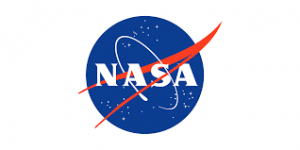 on a ride beyond LEO, to the Moon and back, and in five years it will transport the next people to a lunar orbital post.
on a ride beyond LEO, to the Moon and back, and in five years it will transport the next people to a lunar orbital post.
NASA’s Orion spacecraft has been using additive manufacturing technologies exponentially. Lockheed Martin and NASA recently announced the completion of the Orion crew and service module being developed for the uncrewed Artemis I mission, which used 100 3D printed parts. While the spacecraft for the Artemis II mission has Lockheed developing close to 200 3D printed parts.

The Orion crew module for Exploration Mission 1 that will launch atop NASA’s Space Launch System rocket on its first uncrewed integrated flight (Image credit: NASA)
Last September, NASA, and Lockheed finalized a contract for the production and operations of six Orion spacecraft missions with an option to order up to 12 in total. The agency’s Orion Production and Operations Contract (OPOC) is an indefinite-delivery, indefinite-quantity (IDIQ) contract for NASA to issue both cost-plus-incentive-fee and firm-fixed-price orders. Initially, NASA has ordered three Orion spacecraft for Artemis missions III through V for $2.7 billion. Then in 2022, the agency plans to order three additional Orion spacecraft for Artemis missions VI through VIII for $1.9 billion. Up to six additional Orion spacecraft may be ordered under the IDIQ contract through 2030, leveraging spacecraft production cost data from the previous six missions to enable the lowest possible unit prices.
During an interview with Lockheed Martin Space’ specialists Brian Kaplun, Manager of the Additive Manufacturing Lab, and Colin Sipe, Orion Crew Systems Senior Manager, 3DPrint.com delved into the makings of America’s next spacecraft for a new generation of explorers.
How has additive manufacturing helped in the creation of more efficient spacecraft?
“One of the tenants of advanced manufacturing is to increase the cost and the schedule efficiency for any of our platforms, including Orion, and doing so in a way that, at the very least, maintains parity from a technical perspective but in many cases enhances that. So a lot of the work we’ve done with Orion was targeted to allow for a more efficiently reusable, cost-competitive and faster time to delivery spacecraft that will have a better technical performance. For example our docking hatch covers were printed in a cost and schedule effective manner; additionally, thanks to a new ESD compliant polymer (a type of no-static plastic) we provided more technical performance as well,” suggested Kaplun. “AM is one tool in the advance manufacturing toolbox that really allows us to hit all three of those valuable points. The plan is to continue creating AM components that we already utilized and look at increasing the number.”
While Colin Sipe explained that “we do a lot of parts that would be traditionally difficult to produce, such as structural components and brackets, different parts to channel airflow, or fuel containers, like hydrogen fuel tanks. Moreover, on the seats that the astronauts will use on Orion, we 3D printed different spacers (parts that go between the edge of the seat and the hip of the astronaut) and those come in various sizes based on the astronaut using it. We have to be able to accommodate from 1 to 99th percentile of the average American size individual.”
Do 3D printed parts withstand some of the harshest conditions in space?
“We fully qualify any of our spacecraft and platforms, and it is a qualification born of many years of doing this. On 2011 we launched the first-ever 3D printed part going to outer space on our Juno mission and right now those parts are orbiting the gas giant. So just as rigorous as we did in 2011, here in the last throes of 2019 we have to go through and really qualify any of the Orion parts. Even more so, with future manned missions, we are going to further stress those qualifications. Its a challenge that we are very experienced in and really believe we are up for,” claimed Kaplun. “Experience in any way, shape or form is going to be a competitive advantage for Lockheed.”
How do you choose the design for the 3D printed parts?
“We have produced many different parts for our customers that almost have an organic shape to them and so if you look at some of the new designs where you are optimizing for strength in terms of weight and producibility, you will observe that they mimic the bones in your arm like a very evolved and efficient method of support. If we look at some of the structural brackets that we have done, they almost have a tree or a skeletal structure look to them, that is a very unique mindset or would have been a unique mindset when we were looking at the substractive and traditional manufacturing. But now that people are being trained for AM, we notice that there are a lot more technically complex designs. Some of the ESD parts that we made for Orion would be virtually imposible ot make any other way,” revealed Kaplun. “Now, we are able to combine a large number of other parts into one piece and eliminate a lot of the fasteners and the weight that otherwise would have been a parasitic load, providing greater opportunities to put payloads and scienitic instruments onto our platforms.”
In what way does 3D printing drive down spacecraft costs?
“We try for a really ambitious cost reduction, aiming at 50%. Over the last year, we printed roughly 6,500 parts across our entire space division. Recently we even used AM technology to develop mockups for tests, such as the toilet that will be used on Orion, called the UWMS,” proposed Sipe. “We were concerned about one area of interference so we printed the entire mockup of the toilet and put it into the flight vehicle to verify that we could reach and access the bolts. The size of that toilet is probably two feet in diameter and three feet tall, so it was a very large piece to produce.”
How does Lockheed factor in sustainability when 3D printing its pieces?
Kaplun indicated that at Lockheed, engineers are “very proud of how sustainable our technology is. Our polymer builds can be recycled and reused if needed, the powder bed processes are extremely efficient and the industry as a whole is considered very sustainable and cost-efficient from a materials perspective. Some of the waste for our additive processes can be lower than five percent. When you compare that to some of the subtractive and traditional manufacturing applications, those numbers flip completely, producing 90% waste.”
Would you be able to convey how many AM parts were used for Orion?
“We made 200 components for the Artemis II Orion spacecraft. While the Artemis I had over 100 printed pieces and the previous version had only four 3D printed parts. This reveals that only one spacecraft generation later, we were able to double the amount of 3D printed parts,” reported Sipe.
What can we expect to see during the Artemis II mission scheduled for late 2020?
“Our next mission will launch Orion on a Space Launch System (SLS) rocket, which will be the largest rocket ever built as far as liftoff power. Next year we can expect an unmaned service module to travel to the lunar orbit where it will stay for a month, carry out significant checkouts of all of our modules and will be the first launch on the new rocket. Once it returns to Earth, we will recover it, take it apart, see what we can reuse, what we need to make some improvements on, and at the same time, we’ll be getting ready for our Artemis II mission, with the first astronauts flying on 2022. Then, Artemis III in 2024, will take astronauts to Gateway, a small space station in the lunar orbit, and from there to a human landing system that will put the first woman and next man on the Moon surface. This will be the first of many missions to the Moon’s south pole, where bases and moon mining will begin,” said Sipe.
Are there more engineers interested in AM technology applications?
According to Kaplun, there has been much interest in AM: “we are witnessing a lot of students and scholars contributing to the design space, coming into our engineering and production ranks with a lot of previous work in the field, with new ideas and new abilities to utilize the tools that we can now offer.”
As an engineer, how do you change your mindset to produce something from a subtractive standpoint to an additive one?
“We are starting to corrupt the threshold as we are beginning to design parts that can only be made via the additive route, whereby in the past we would sort of take something that was designed for a normal conventional machine and then transition it to the additive world,” told Sipe. “Today we are generating designs that we know the only way they can be made is through AM. There are certain parts of the spacecraft that couldn’t be done with other technologies, such as hollow, organically grown on the printer parts that create new opportunities for us.”
What 3D printing technologies are being used at Lockheed?
“We have a very large gamut of different types of technologies to make the 3D printed parts for Orion, the docking hedge covers were made on Stratasys FDM printers, but we also use a lot of metal powder bed technologies in various forms as well as different polymer technologies,” the experts proposed.
So what lays ahead for the aerospace company?
“We just got into a long term production contract with NASA for the six upcoming spacecraft missions, so I believe it is our goal to make even more 3D printed parts for spacecraft. A big focus of the contract was to dramatically reduce per-vehicle costs and the major ways of doing that was by having reusable Orion crew modules and systems, using advanced manufacturing technologies, material and component bulk buys and an accelerated mission cadence. I consider that AM is a large part of reducing the cost and increasing the cadence of how often we fly,” enlightened Kaplun.
Both Kaplun and Sipe consider that the “Orion spacecraft is part of NASA’s backbone for deep space exploration.”
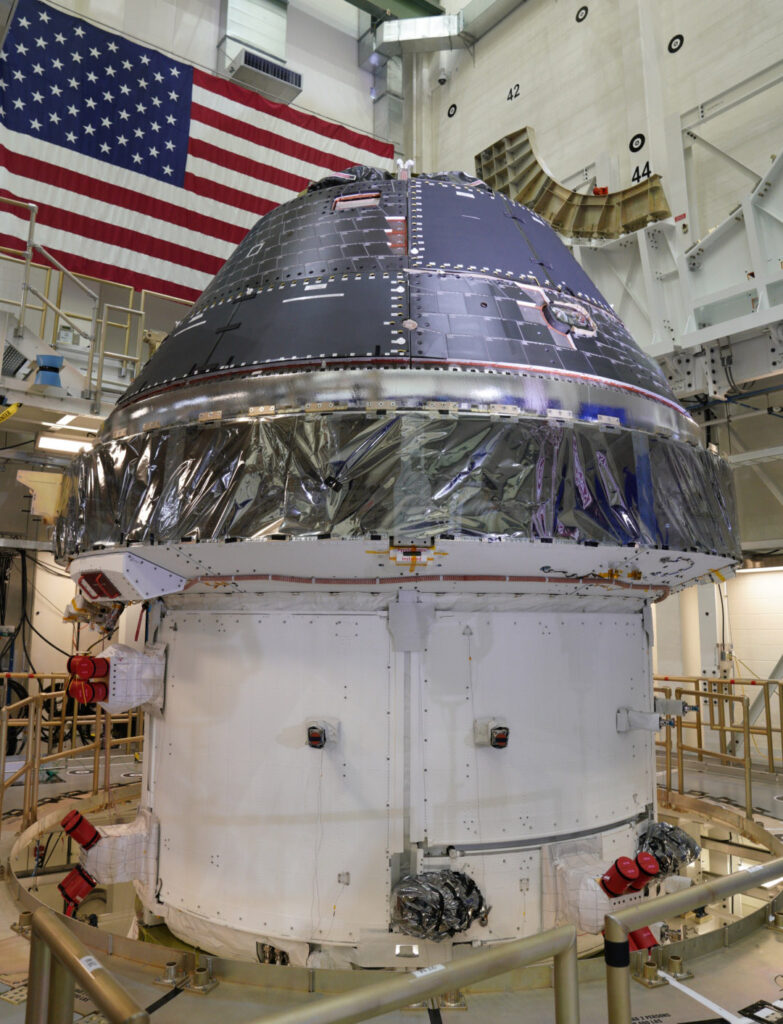
The completed Orion spacecraft crew module at the NASA Kennedy Space Center (Image credit: Lockheed Martin)
With work well underway on both the Artemis I and II rockets, with core stage assembly nearly complete at Michoud, Orion will leave Lockheed for testing at NASA’s Stennis Space Center near Bay St. Louis, in Mississippi.
Sipe concluded that: “In 1981, NASA wanted to move back into deep space so since 1981 we were flying the space shuttle, and physically could not go outside the Earth’s orbit, the Apollo was the last spacecraft that physically could leave the gravity of the Earth and move into deep space, and NASA had a desire for mankind to return. Orion is the only spacecraft development that is a true exploration class spacecraft. It’s not like any other, it has unique capabilities never before seen and even though the capsule is a heritage of the Apollo mission, its actually far superior.”
The post Interview with Lockheed: “Orion Spacecraft Has 200 3D Printed Components” appeared first on 3DPrint.com | The Voice of 3D Printing / Additive Manufacturing.
3D Printing Industry News Sliced: Nano Dimension, Protolabs, Lockheed Martin, CRP, Prusa, Siemens
3DEXPERIENCE Modeling & Simulation Conference: Keynote by Skunk Works & Executive Roundtable
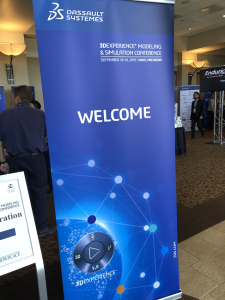 Last week, Dassault Systèmes, the 3DEXPERIENCE software company, held the 3DEXPERIENCE Modeling & Simulation Conference in Michigan. I was invited to attend the event, which was held from September 18-19 at the Suburban Collection Showplace in Novi.
Last week, Dassault Systèmes, the 3DEXPERIENCE software company, held the 3DEXPERIENCE Modeling & Simulation Conference in Michigan. I was invited to attend the event, which was held from September 18-19 at the Suburban Collection Showplace in Novi.
At the first plenary session, keynote speaker Clifton Davies, a Principal Aeronautical Engineer for Lockheed Martin Skunk Works, talked about the defense contractor’s use of the 3DEXPERIENCE platform, and its simulation process and design exploration apps, to work on aircraft design for the non-proprietary EXPEDITE project.
Skunk Works began working with the Air Force Research Laboratory (AFRL) on the EXPEDITE project in 2017. According to ESTECO, EXPEDITE, which stands for EXPanded MDO for Effectiveness Based DesIgn TEchnologies, is the latest in a series of successful AFRL programs with a goal of advancing “the state-of-the-art of Multi-disciplinary Analysis and Design Optimization (MADO)” for USAF programs. The project aims to rapidly improve early conceptual MDO capabilities for the aerospace industry in several areas, including Effectiveness-Based Design (EBD), high-performance computing, and cost and reliability.
“Whatever your business process is, there’s a good chance it needs high-performance computing,” Davies said.
He explained what EXPEDITE was currently working on, stating that efficiency and support of higher fidelity physics are necessary for the tasks, which included next generation mobility, next generation UAS, and high-speed systems.
In terms of delivering EBD to customers, Davies said that the most important aspect to keep in mind is not how fast or far it can go, but if it finished the job in an affordable way. He said the design process needs to be taken “down into the statistics” to find the answer.
Davies continued, “What’s the probability it can complete the mission?”
Skunk Works wanted to make sure that risk to the USAF was minimal for the project, and wasn’t sure if there was anyone in the MDO framework industry capable of handling it. So the company partnered with Dassault, and several other companies, to determine who could best address the particular challenges of EXPEDITE.
In terms of what the company is using on the 3DEXPERIENCE platform, the focus is mainly on MDO tools, such as SIMULIA.
“We’re leveraging SIMULIA apps for creating MDO workflows,” Davies said. “We built the aircraft design workflows for the program using the SIMULIA apps.”
3DEXPERIENCE platform implementations can vary from very large to very small. The EXPEDITE project set up the platform on multiple virtual machines in Palmdale, California and Fort Worth, Texas, so more work could be distributed to more locations.
Davies then showed a slide which illustrated the conceptual design workflow that Lockheed Martin uses for the aircraft elements it’s executing with 3DEXPERIENCE. It’s broken down into multiple activities, based on both where the project might be executed and by which group.
The company has also integrated the V5 version of Dassault’s CATIA software program, and even built on top of it due to “multiple customizations,” which is why the newest version of the software was not used. Because an adapter did not exist, the company had to connect CATIA via COM interface through a VBScript driver they wrote.
But the company really wanted an adapter, and Davies said that Dassault “really came through for us.”
“It [the adapter] supports the normal things you’d expect, but this also supports Macros, which lets you leverage your IP and capability with geometry to get out what you need to do,” Davies explained.
He said that one of the most useful features of the plugin that the CATIA team created for EXPEDITE is a Screen Capture capability: it allows users to see exactly where the process failed, which really helps to reduce run time.
Moving back to computing, Davies said that the next generation of super computers will offer plenty of flexibility in terms of the various 3DEXPERIENCE platforms users can visit.
Davies wrapped up by discussing the company’s lessons learned, next steps, and future needs in terms of 3DEXPERIENCE. He talked about how nice it was to be able to load design data without having to leave the platform, in addition to being able to compare designs in tabular and graphical form, apply constraints, and having opportunities to streamline the user’s post-processing experience.
In closing, Davies said that he encourages Dassault Systèmes to “continue improving ergonomics for debugging models, best practices for large model distribution,” and the overall user experience.
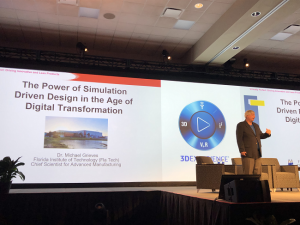 Next up, PLM expert Dr. Michael Grieves, Chief Scientist for Advanced Manufacturing at the Florida Institute of Technology and the father of the digital twin, came onstage to speak for a few minutes before moderating the executive roundtable.
Next up, PLM expert Dr. Michael Grieves, Chief Scientist for Advanced Manufacturing at the Florida Institute of Technology and the father of the digital twin, came onstage to speak for a few minutes before moderating the executive roundtable.
“We’re doing a lot of exciting things,” Dr. Grieves said.
“What I want to talk about is the digital twin – the model I developed.”
He talked about how in the 21st century, we developed 3D models and created a virtual space filled with virtual products – a big change from years past.
“At the beginning, we actually have a digital twin before we have the physical thing,” Dr. Grieves explained. “We really have this digital information that we work on. I like to design, test, make, and support the product virtually, and only when I get it all right do I want to make physical things. Ideally, I’d really like to print it – I think additive manufacturing is really going to change how we manufacture things.”
Then he referred back to the point that Davies had made early on – does the product do its job?
“If we can take the digital twin and test that to destruction, I have a better feel for the fact that it will perform the way it’s supposed to perform in the real world. Digital twins will save us a whole lot of resources,” Dr. Grieves said. “I should be able to predict failures and fix them before they happen.”
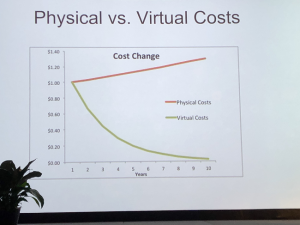 The way to do this, he explained, is by doing as much work as possible in advance on the virtual side.
The way to do this, he explained, is by doing as much work as possible in advance on the virtual side.
“Industry 4.0 is talking about reducing the time of an event occurring to fixing it. I think about the digital twin as figuring out which events will occur and fixing them before they happen.”
With that, Dr. Grieves introduced the three speakers of the executive roundtable: Philippe Laufer, the CEO of CATIA; David Holman, Vice President R&D and Brand Leader for Dassault’s SIMULIA; and Garth Coleman, the VP of Marketing for Dassault’s ENOVIA.
Coleman was in definite agreement with Dr. Grieves’ thoughts on virtualization.
“We can do the modeling of the experience well before you have the product out in the world. We can innovate around that experience, and include the customer in that experience,” he stated.
“Once you have the real twin, you can connect that data in and refine the product, the experiences, everything.”
In this way, Coleman continued, companies can achieve cost savings, with maximum flexibility, early on in the process.
Then Dr. Grieves asked the experts how they felt about this kind of connectivity – how smart, connected products “fit in to what we do.” Coleman brought up the fact that the IoT and the IIoT are both “generating boatloads of data,” which is interesting for companies to have access to. But, he wondered if customers were using the features in the correct way.
“Being able to be in tune to all the trends and your finicky and satisfied customers is really important,” he said. “But what’s a great experience today – a better one may come along tomorrow.”
Holman chimed in here, stating that the digital twin is a good tool for success, as major challenges companies today face include the demand for increased customization and better quality.
“The only way to keep up is with the true 3DEXPERIENCE digital twin,” Holman said.
Dr. Grieves then asked Laufer for his opinion regarding the 3DEXPERIENCE digital twin.
“All signs show that we are changing the world,” he answered. “Experience is not at the level it should be, so it’s the time for the industry renaissance, and to have the citizen, consumer, and patient at the heart of the experience you’re creating.”
Laufer brought up cars, and talked about simply riding in one versus the driving experience; for example, Laufer asked the audience members how many of us were satisfied with our car’s air conditioning. He mentioned that during a recent visit to Boeing, company representatives discussed the flight experience, as opposed to just delivering an airplane, and wanted to know why we weren’t all talking about the Industry Renaissance.
“The new book is the experience,” Laufer stated, quoting Dassault. “We are creating a 3DEXPERIENCE twin. In the virtual world, you can blow on it, push it, pull it.”
Dr. Grieves asked him how we can help customers “bridge the gap” between the physical and virtual worlds. Laufer explained that companies are using cyber systems to create these experiences, and that we have to be able to create, master, and model those systems – after all, when you want to make music, you must first practice the scales. In most companies, a designer creates the concept for a product and passes it on to the analyst engineer, who then runs simulations and sends it back for the changes to be made. The 3DEXPERIENCE platform is able to streamline all of these processes.
He asked, “How can you automate if you don’t do it properly in an interactive way?”
Dr. Grieves then brought up how generative design is tied into manufacturing, since we need to be able to create new shapes, and asked Coleman how he feels that it “plays into the classic bill of materials and collaboration.”
“From the ENOVIA side, this is a common thing that everyone wants to achieve – this lack of productivity,” he answered. “The common metric that comes back is 30% – what would you do with 30% of your time back?
“The bill of materials can’t keep up now, it’s too static, it’s too slow,” Coleman continued. “You can’t stimulate and optimize this. So it’s really a report of where you’re at – basically a 2D drawing.”
Turning to Holman, Dr. Grieves asked him where simulation fit.
“Basically, we can provide the tools, the manpower, the signers, and the innovators to build products that behave the way they are intended. This is what we’re bringing together with generative design,” Holman answered.
“In the end, the products we create have to deliver the right experiences to the customers, they have to be sustainable.”
Dr. Grieves then asked Coleman his perspective of where he thought everything in the discussion fit in.
“Requirements are driving everything, including what you do in modeling and simulation,” he said. “A lot of times, these are managed in emails, sticky notes, documents, Excel files, so on. Traditionally, we can do file management, and we do it well. But we need to move past this and start managing the innovation. Extract the important information as data, and connect it.”
Laufer then had the chance to share his views on the matter.
“The challenge engineering teams face is you have a problem in front of you – the topic is to optimize several KPI. How do you model in your current system? We have a way in the platform to follow KPIs while you’re designing and simulating to make sure you’re going in the right direction. This solution will augment the engineering teams by allowing them to explore, and simulate.
“I’m heavily using David’s technology in my CATIA applications,” Laufer continued. “Your role as an engineering team will be to explore, simulate, and optimize – the geometry, material composition, material selection, manufacturing process. This is what the future of engineering is about. The 3DEXPERIENCE platform provides this integrated environment that lets stakeholders of these decisions play together. 3DEXPERIENCE is multidisciplinary.”
Finally, Dr. Grieves asked each participant what the most important takeaway from the discussion was for the audience to understand. Holman stated that SIMULIA was making some strong investments in order to fulfill the promise of making high fidelity simulation more accessible, which “is gong to be great for all of you.” Coleman explained that ENOVIA is working to optimize things at the business process level, as it concerns “organizing and orchestrating all of this, and being able to modify the plan.”
Laufer said, “Speaking to you as users, your job will evolve. Simulation experts will be able to modify mesh, and work with the designer to propose alternatives. I think there’s going to be a fusion, but don’t be afraid of that.”
Stay tuned for more news from my time at the recent 3DEXPERIENCE Modeling & Simulation Conference!
Discuss this story and other 3D printing topics at 3DPrintBoard.com or share your thoughts in the Facebook comments below.
[Photos by Sarah Saunders]
The post 3DEXPERIENCE Modeling & Simulation Conference: Keynote by Skunk Works & Executive Roundtable appeared first on 3DPrint.com | The Voice of 3D Printing / Additive Manufacturing.
Marshall ADG to 3D print functional aircraft parts with Stratasys Fortus 450mc
FELIXprinters: Accelerating industrial product development with FFF 3D printing
3D Printing News Sliced Nano Dimension, UNIZ Tech, Lockheed Martin, Roland DGA
Top 10 3D Printing Aerospace Stories from 2018
3D printing has played an important role in many industries over the past year, such as medical, education, and aerospace. It would take a very long time to list all of the amazing news in aerospace 3D printing in 2018, which is why we’ve chosen our top 10 stories for you about 3D printing in the aerospace industry and put them all in a single article.
Sintavia Received Approval to 3D Print Production Parts for Honeywell Aerospace
Tier One metal 3D printer manufacturer Sintavia LLC, headquartered in Florida, announced in January that it is the first company to receive internal approval to 3D print flightworthy production parts, using a powder bed fusion process, for OEM Honeywell Aerospace. Sintavia’s exciting approval covers all of Honeywell’s programs.
Boeing and Oerlikon Developing Standard Processes
Boeing, the world’s largest aerospace company, signed a five-year collaboration agreement with Swiss technology and engineering group Oerlikon to develop standard processes and materials for metal 3D printing. Together, the two companies will use the data resulting from their agreement to support the creation of standard titanium 3D printing processes, in addition to the qualification of AM suppliers that will produce metallic components through a variety of different materials and machines. Their research will focus first on industrializing titanium powder bed fusion, as well as making sure that any parts made with the process will meet the necessary flight requirements of both the FAA and the Department of Defense.
FITNIK Launched Operations in Russia
In 2017, FIT AG, a German provider of rapid prototyping and additive design and manufacturing (ADM) services, began working with Russian research and engineering company NIK Ltd. to open up the country’s market for aerospace additive manufacturing. FIT and NIK started a new joint venture company, dubbed FITNIK, which combines the best of what both companies offer. In the winter of 2018, FITNIK finally launched its operations in the strategic location of Zhukovsky, which is an important aircraft R&D center.
New Polymer 3D Printing Standards for Aerospace Industry
The National Institute for Aviation Research (NIAR) at Wichita State University (WSU), which is the country’s largest university aviation R&D institution, announced that it would be helping to create new technical standard documents for polymer 3D printing in the aerospace industry, together with the Polymer Additive Manufacturing (AMS AM-P) Subcommittee of global engineering organization SAE International. These new technical standard documents are supporting the industry’s interest in qualifying 3D printed polymer parts, as well as providing quality assurance provisions and technical requirements for the material feedstock characterization and FDM process that will be used to 3D print high-quality aerospace parts with Stratasys ULTEM 9085 and ULTEM 1010.
Premium AEROTEC Acquired APWORKS
Metal 3D printing expert and Airbus subsidiary APWORKS announced in April that it had been acquired as a subsidiary by aerostructures supplier Premium AEROTEC. Premium AEROTEC will be the sole shareholder, with APWORKS maintaining its own market presence as an independent company. Combining the two companies gave clients access to 11 production units and a wide variety of materials.
Gefertec’s Wire-Feed 3D Printing Developed for Aerospace
Gefertec, which uses wire as the feedstock for its patented 3DMP technology, worked with the Bremer Institut für Angewandte Strahltechnik GmbH (BIAS) to qualify its wire-feed 3D printing method to produce large structural aerospace components. The research took place as part of collaborative project REGIS, which includes several different partners from the aerospace industry, other research institutions, and machine manufacturers. Germany’s Federal Ministry for Economic Affairs and Energy funded the project, which investigated the influence of shielding gas content and heat input on the mechanical properties of titanium and aluminium components.
Research Into Embedded QR Codes for Aerospace 3D Printing
It’s been predicted that by 2021, 75% of new commercial and military aircraft will contain 3D printed parts, so it’s vitally important to find a way to ensure that 3D printed components are genuine, and not counterfeit. A group of researchers from the NYU Tandon School of Engineering came up with a way to protect part integrity by converting QR codes, bar codes, and other passive tags into 3D features that are hidden inside 3D printed objects. The researchers explained in a paper how they were able to embed the codes in a way that they would neither compromise the integrity of the 3D printed object or be obvious to any counterfeiters attempting to reverse engineer the part.
Lockheed Martin Received Contract for Developing Aerospace 3D Printing
Aerospace company Lockheed Martin, the world’s largest defense contractor, was granted a $5.8 million contract with the Office of Naval Research to help further develop 3D printing for the aerospace industry. Together, the two will investigate the use of artificial intelligence in training robots to independently oversee the 3D printing of complex aerospace components.
BeAM And PFW Aerospace Qualified 3D Printed Aerospace Component
BeAM, well-known for its Directed Energy Deposition (DED) technology, announced a new partnership with German company PFW Aerospace, which supplies systems and components for all civilian Airbus models and the Boeing 737 Dreamliner. Together, the two worked to qualify a 3D printed aerospace component, made out of the Ti6Al4V alloy, for a large civil passenger aircraft, in addition to industrializing BeAM’s DED process to manufacture series components and testing the applicability of the method to machined titanium components and complex welding designs.
Researchers Qualified 3D Printed Aerospace Brackets
Speaking of parts qualification, a team of researchers completed a feasibility study of the Thermoelastic Stress Analysis (TSA) on a titanium alloy space bracket made with Electron Beam Melting (EBM) 3D printing, in order to ensure that its mechanical behavior and other qualities were acceptable. The researchers developed a methodology, which was implemented on a titanium based-alloy satellite bracket.
Discuss these stories and other 3D printing topics at 3DPrintBoard.com or share your thoughts below.

